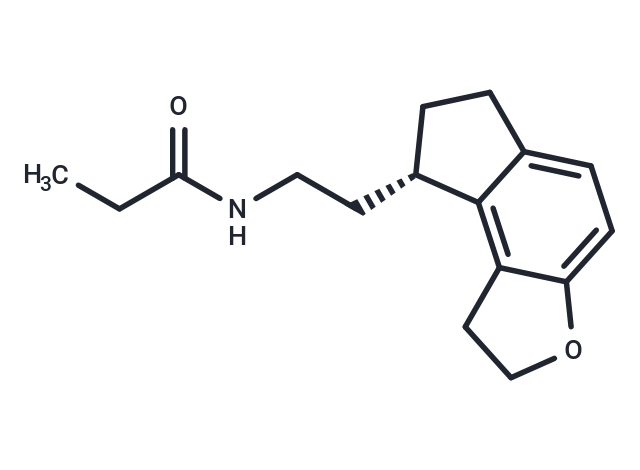Shopping Cart
- Remove All
 Your shopping cart is currently empty
Your shopping cart is currently empty

Ramelteon (TAK-375) is a Melatonin Receptor Agonist. The mechanism of action of ramelteon is as a Melatonin Receptor Agonist.

| Pack Size | Price | Availability | Quantity |
|---|---|---|---|
| 2 mg | $37 | In Stock | |
| 5 mg | $59 | In Stock | |
| 10 mg | $80 | In Stock | |
| 25 mg | $138 | In Stock | |
| 50 mg | $213 | In Stock | |
| 100 mg | $343 | In Stock | |
| 500 mg | $539 | In Stock | |
| 1 mL x 10 mM (in DMSO) | $65 | In Stock |
| Description | Ramelteon (TAK-375) is a Melatonin Receptor Agonist. The mechanism of action of ramelteon is as a Melatonin Receptor Agonist. |
| Targets&IC50 | MT2 receptor:112 pM(Ki), MT receptor (chicken):23.1 pM(Ki), MT1 receptor:14 pM(Ki) |
| In vitro | Ramelteon inhibited melanocyte pigment granule aggregation in the African clawed toad (Xenopus laevis) with a pEC50 of 11.48.1 nM Ramelteon increased ERK1/2 phosphorylation not only in MT1/MT2 cerebellar granule cells, but also in cerebellar granule cells containing only one melatonin receptor.Ramelteon inhibits forskolin-stimulated cAMP production with an IC50 of 21.2 pM in CHO cells. 4P-PDOT blocked the stimulatory effect of Ramelteon (1 nM) in MT1 KO cerebellar granule cells, whereas luzindole attenuated the effect of Ramelteon (1 nM) in MT2 KO cerebellar granule cells. Ramelteon showed high affinity for recombinant human MT1 and MT2 receptors with pKi of 10.05 and 9.70, respectively. |
| In vivo | Ramelteon inhibited melanocyte pigment granule aggregation in the African clawed toad (Xenopus laevis) with a pEC50 of 11.48.1 nM Ramelteon increased ERK1/2 phosphorylation not only in MT1/MT2 cerebellar granule cells, but also in cerebellar granule cells containing only one melatonin receptor.Ramelteon inhibits forskolin-stimulated cAMP production with an IC50 of 21.2 pM in CHO cells. 4P-PDOT blocked the stimulatory effect of Ramelteon (1 nM) in MT1 KO cerebellar granule cells, whereas luzindole attenuated the effect of Ramelteon (1 nM) in MT2 KO cerebellar granule cells. Ramelteon showed high affinity for recombinant human MT1 and MT2 receptors with pKi of 10.05 and 9.70, respectively. |
| Kinase Assay | cDNA encoding the human MT1 gene is introduced into CHO cells. Cells are harvested at confluence in Ca2+ and Mg2+ free Hanks' balanced salt solution containing 5 mM EDTA and collected by centrifugation. Cells are homogenized in ice-cold 50 mM Tris–HCl buffer, washed twice, pelleted, and stored at -30°C until the binding assays are conducted. Test compound and 40 pM 2-[ 125I]melatonin are mixed with the thawed homogenate in a total volume of 1 mL and incubated at 25°C for 150 min. The reaction is terminated by addition of 3 mL of icecold buffer followed by vacuum filtration on a Whatman GF/B. The filter is washed twice and radioactivity is counted by a g-counter[1]. |
| Alias | TAK-375 |
| Molecular Weight | 259.34 |
| Formula | C16H21NO2 |
| Cas No. | 196597-26-9 |
| Smiles | CCC(=O)NCC[C@@H]1CCc2ccc3OCCc3c12 |
| Relative Density. | 1.119g/cm3 |
| Storage | store at low temperature | Powder: -20°C for 3 years | In solvent: -80°C for 1 year | Shipping with blue ice. | |||||||||||||||||||||||||||||||||||
| Solubility Information | H2O: < 1 mg/mL (insoluble or slightly soluble) Ethanol: 49 mg/mL (188.94 mM), Sonication is recommended. DMSO: 60 mg/mL (231.36 mM), Sonication is recommended. | |||||||||||||||||||||||||||||||||||
Solution Preparation Table | ||||||||||||||||||||||||||||||||||||
Ethanol/DMSO
| ||||||||||||||||||||||||||||||||||||

Copyright © 2015-2025 TargetMol Chemicals Inc. All Rights Reserved.